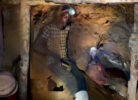The wall texts throughout the exhibition illustrate the complexity of the global supply chain for gold and rare minerals. – Scroll down for additional information.
Despite the dire situation and the scandalous exploitation of a large portion the workers and their families, artisanal mining also provides a livelihood for millions of people around the globe. It is estimated that at least 134 million people work in related industries that support artisanal and small scale mining activities, including small-scale processing, buying and selling, but also restaurants and bars, shops, equipment, and transport facilities.
Gold is one of the many minerals that are necessary for the digital industry. Other rare minerals, such as cobalt and colombo-tantalite (coltan) deserve similar attention. Colombo-tantalite is used for producing performative capacitators to store and transfer electric energy in digital devices. Cobalt is used to build lithium-ion batteries. Both minerals have attracted negative publicity for their contribution to dire working conditions, child labor and armed conflict in the Democratic Republic of Congo (DRC).
Allegations concerning such «conflict minerals» have led the US and the EU to introduce restrictive legislations for companies in the industry. The tantalum industry in turn is investing time and energy into an ethical supply chain with different pilot projects in DRC. But while ITSCI (International Tin Research Institute Supply Chain Initiative) reports improvements thanks to its intervention, the initiative has been accused of establishing a monopoly, which, once again, discriminates against artisan miners.
Recommended further reading: ITSCI Programme for Responsible Mineral Supply Chains, IRA International Rights Advocates, Book: Conflict Minerals Inc., Article: Terr(it)or(ies) of Peace?, IPS Report: How much does a miner earn?, Situation socio-economique des menages vivant dans et au-tour des sites miniers du Sud-Kivu (in French)
More about the global context:
Artisanal vs. Industrial Mining
Stigmatized Workers
How About Switzerland?
What Can We Do?
Share your impressions, observations and questions on our visitors' comments page.
Department of Geography, University of Zurich:
Research, interviews, 3D scans, videos, photographs: Gabriel Kamundala, Department of Geography, UZH
Supervision and textual content: Dr. Timothy Raeymaekers, Department of Geography, UZH,
Dr. Muriel Côte, Associate senior lecturer, Department of Human Geography, University of Lund
Research partners:
University of Zimbabwe
University of Ouagadougou I
Institut National des Sciences des Sociétés (Burkina Faso)
Groupe d’Etudes sur les Conflits et la Sécurité Humaine (DR CONGO)
Immersive Arts Space, Zurich University of the Arts ZHdK:
Scenography: Mariana Vieira Gruenig
Interaction Design, 3D Experience: Chris Elvis Leisi
Spatial Augmented Reality Engineer: Florian Christoph Bruggisser
Video editing, storytelling: Alan Sahin
Sound design: Patrycja Pakiela
Additional on location audio recordings: Alfred Borauzima
Translation, proofreading: Alliance Riziki Murhula, Edward Wright
Voice over: Shabnam Chamani, Rino Hosennen
Chief technician: Sébastien Schiesser
Production manager: Kristina Jungic
Project lead: Prof. Christian Iseli
